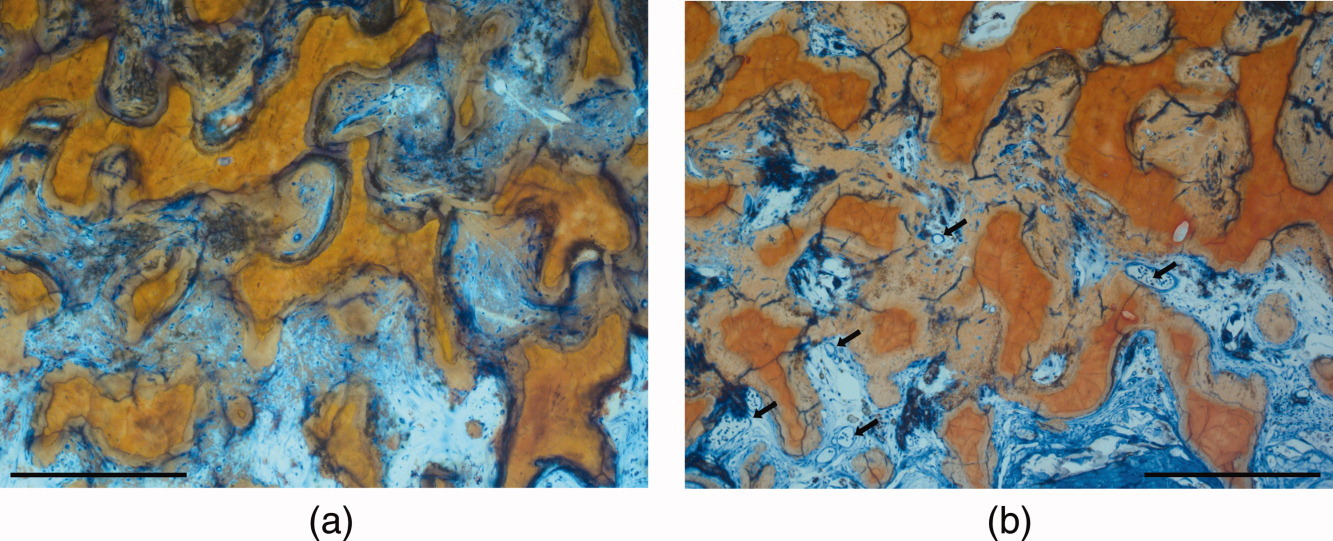The aim of the present study was to test the hypothesis that both scaffold material and the type of cell culturing contribute to the results of in vivoosteogenesis in tissue-engineered constructs in an interactive manner. CaCO3 scaffolds and mineralized collagen scaffolds were seeded with human trabecular bone cells at a density of 5 - 106 cells/cm3 and were left to attach under standard conditions for 24 h. Subsequently, they were submitted to static and dynamic culturing for 14 days (groups III and IV, respectively). Dynamic culturing was carried out in a continuous flow perfusion bioreactor. Empty scaffolds and scaffolds that were seeded with cells and kept under standard conditions for 24 h served as controls (groups I and II, respectively). Five scaffolds of each biomaterial and from each group were implanted into the gluteal muscles of rnu rats for 6 weeks. Osteogenesis was assessed quantitatively by histomorphometry and expression of osteocalcin (OC) and vascular endothelial growth factor (VEGF) was determined by immunohistochemistry. CaCO3 scaffolds exhibited 15.8% (SD 3.1) of newly formed bone after static culture and 22.4% (SD 8.2) after dynamic culture. Empty control scaffolds did not show bone formation, and scaffolds after 24 h of standard conditions produced 8.2% of newly formed bone (SD 4.0). Differences between the controls and the scaffolds cultured for 14 days were significant, but there was no significant difference between static and dynamic culturing. Mineralized collagen scaffolds did not show bone formation in any group. There was a significant difference in the expression of OC within the scaffolds submitted to static versus dynamic culturing in the CaCO3 scaffolds. VEGF expression did not show significant differences between static and dynamic culturing in the two biomaterials tested. It is concluded that within the limitations of the study the type of biomaterial had the dominant effect on in vivobone formation in small tissue-engineered scaffolds. The culture period additionally affected the amount of bone formed, whereas the type of culturing may have had a positive effect on the expression of osteogenic markers but not on the quantity of bone formation.

The aim of the present study was to test the hypothesis that both scaffold material and the type of cell culturing contribute to the results of in vivoosteogenesis in tissue-engineered constructs in an interactive manner. CaCO3 scaffolds and mineralized collagen scaffolds were seeded with human trabecular bone cells at a density of 5 - 106 cells/cm3 and were left to attach under standard conditions for 24 h. Subsequently, they were submitted to static and dynamic culturing for 14 days (groups III and IV, respectively). Dynamic culturing was carried out in a continuous flow perfusion bioreactor. Empty scaffolds and scaffolds that were seeded with cells and kept under standard conditions for 24 h served as controls (groups I and II, respectively). Five scaffolds of each biomaterial and from each group were implanted into the gluteal muscles of rnu rats for 6 weeks. Osteogenesis was assessed quantitatively by histomorphometry and expression of osteocalcin (OC) and vascular endothelial growth factor (VEGF) was determined by immunohistochemistry. CaCO3 scaffolds exhibited 15.8% (SD 3.1) of newly formed bone after static culture and 22.4% (SD 8.2) after dynamic culture. Empty control scaffolds did not show bone formation, and scaffolds after 24 h of standard conditions produced 8.2% of newly formed bone (SD 4.0). Differences between the controls and the scaffolds cultured for 14 days were significant, but there was no significant difference between static and dynamic culturing. Mineralized collagen scaffolds did not show bone formation in any group. There was a significant difference in the expression of OC within the scaffolds submitted to static versus dynamic culturing in the CaCO3 scaffolds. VEGF expression did not show significant differences between static and dynamic culturing in the two biomaterials tested. It is concluded that within the limitations of the study the type of biomaterial had the dominant effect on in vivobone formation in small tissue-engineered scaffolds. The culture period additionally affected the amount of bone formed, whereas the type of culturing may have had a positive effect on the expression of osteogenic markers but not on the quantity of bone formation.
